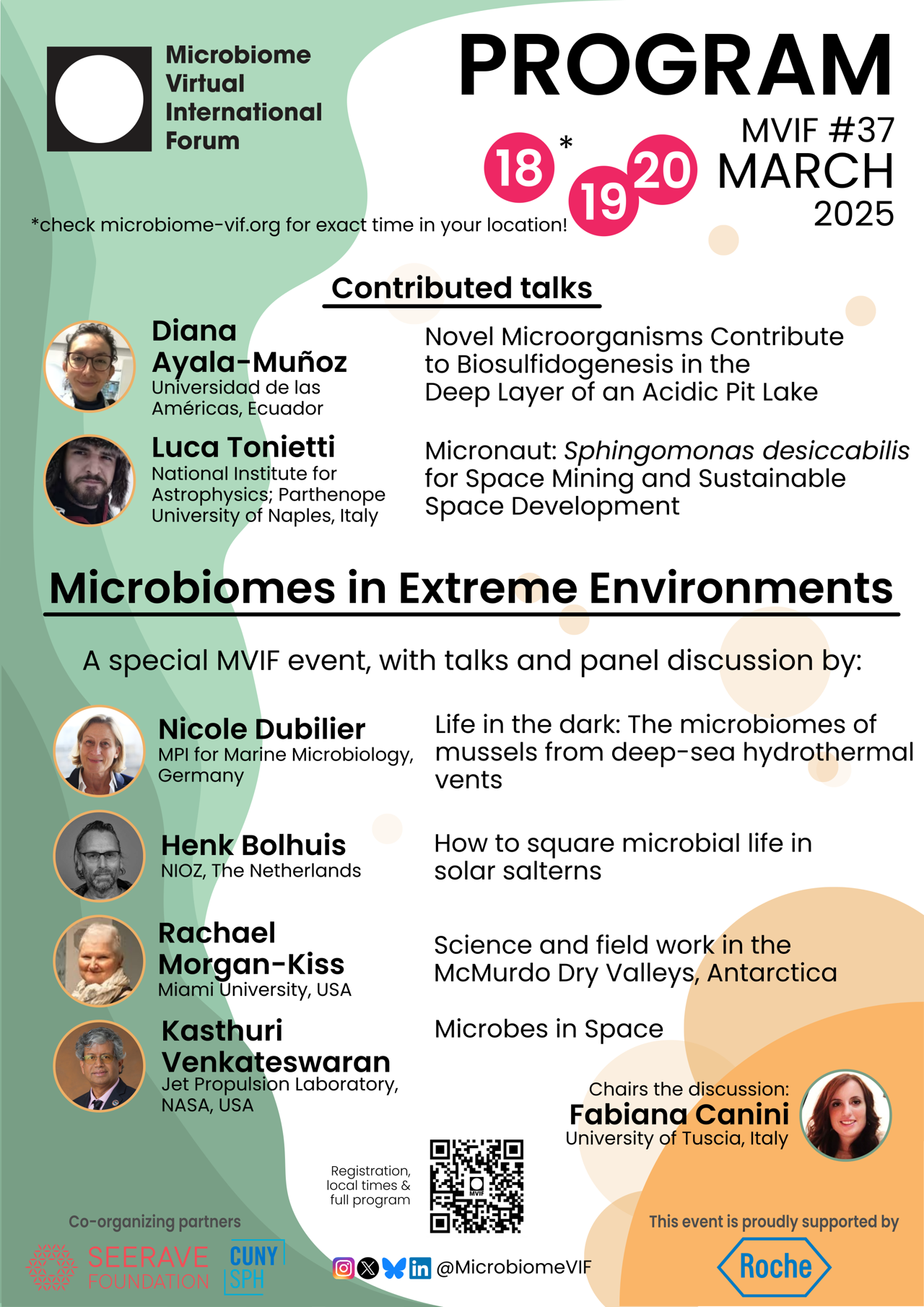Microbiomes in Extreme Environments
A special MVIF event, with talks and panel discussion by:
- Dr. Nicole Dubilier, Director Department of Symbiosis, Max Planck Institute for Marine Microbiology, Germany
- Dr. Henk Bolhuis, NIOZ Royal Netherlands Institute for Sea Research, The Netherlands
- Dr. Rachael Morgan-Kiss, Professor of Environmental Microbiology, Miami University, USA
- Dr. Kasthuri Venkateswaran, NASA – Jet Propulsion Laboratory, leading ISS “Microbial Observatory” projects, USA
Chairs the discussion Dr. Fabiana Canini, University of Tuscia, Italy.
The panel will follow a session of contributed talks. Details about the contributed talks can be found below.
1. Life in the dark: The microbiomes of mussels from deep-sea hydrothermal vents
by Dr. Nicole Dubilier, Director Department of Symbiosis, Max Planck Institute for Marine Microbiology, Germany
The manner in which the microbiome is acquired and persists over the lifetime of hosts shapes the ecology and evolution of both beneficial and pathogenic associations. However, our understanding of microbial acquisition and persistence is still rudimentary, particularly in the vast diversity of life that is not genetically tractable, so-called non-model organisms. Bathymodiolus mussels have fascinated biologists since their discovery in the early 1980s at deep-sea hydrothermal vents. These mussels thrive in the deep sea, far away from the photosynthetic primary production at the ocean surface, thanks to their intimate symbiosis with bacteria that provide them with nutrition. In addition to their beneficial symbionts, bathymodioline mussels also host a pathogen, Ca. Endonucleobacter, that infects their nuclei. A single pathogen invades the mussel's nuclei, replicates there, generating up to 80,000 cells and causing the nuclei to swell to 50 times their original size, and eventually escapes when the infected mussel cell bursts. In my talk, I will describe the combined molecular and imaging approaches we are using to gain insights into how the beneficial and pathogenic microbiota of deep-sea mussels enter and persist in their hosts, and how these processes affect the ecology and evolution of these associations.
2. How to Square Microbial life in Solar Salterns
by Dr. Henk Bolhuis, NIOZ Royal Netherlands Institute for Sea Research, The Netherlands
Microbial communities in hypersaline crystallizer ponds are amongst one of the best studied microbial ecosystems. Investigation of these extreme environments followed the scientific and technological developments in the past 50 + years ranging from the initial microscopy observations up to state-of-the-art molecular tools that have now become common practice. The hypersaline ecosystems are dominated by halophilic archaea but essentially contain members of all domains of life including viruses. One of the intriguing discoveries concerned the enigmatic square archaeon Haloquadratum walsbyi that initially resisted isolation for almost 25 years but was finally obtained into pure culture. In this short presentation I will focus on this specific isolate and its presence in its natural environment at the time of sampling.
3. Science and field work in the McMurdo Dry Valleys, Antarctica
by Dr. Rachael Morgan-Kiss, Professor of Environmental Microbiology, Miami University, USA
Antarctica was once thought to be a lifeless continent, defined by its most notably feature, a continuous sheet of ice. However, diverse microbial lifeforms thrive in this otherwise inhospitable habitat, particularly in the rare places where sufficient light and liquid water are available. The McMurdo Dry Valleys (MDVs) harbor one of the most diverse and productive microbial habitats in Antarctica. Nestled within the valleys of the Transantarctic Mountains in Eastern Antarctica, the MDVs are a cold desert region, characterized by dry soils and minimum annual precipitation. Permanently ice-covered lakes represent oases receiving limited light and year-round liquid water for consortia of microorganisms. Within the stratified water columns, diverse communities of protists play important roles in carbon and nutrient cycling within truncated food webs dominated by the microbial loop. Our research group has studied the distribution and function of the MDV lake protist community for nearly two decades. In this seminar long-term studies of Antarctic protists in the field and lab will be discussed
4. Microbes in Space
by Dr. Kasthuri Venkateswaran, NASA – Jet Propulsion Laboratory, leading ISS “Microbial Observatory” projects, USA
Elucidating microbial behavior in space and its potential impact on future space exploration missions are critical. Microorganisms isolated from oligotrophic environments, such as the International Space Station (ISS), analogous habitat on Earth (Inflated Lunar/Mars Analog Habitat), and mission critical NASA assembly facilities, present unique adaptations to survive in nutrient-poor and high-stress conditions. These modifications offer important new perspectives on the evolution of microbial resistance in challenging environments. These include defense mechanisms against environmental stressors including radiation and microgravity, as well as systems for DNA repair and biofilm formation. One of the primary findings of the study is the identification of genes and proteins, such as oxidoreductases and mechanosensitive channels, which indicate convergent evolutionary strategies among diverse bacteria. Under these circumstances, with limited resources and confined space, some molecular traits allow bacteria to thrive. These adaptations are critical to our understanding of microbial survival and have far-reaching consequences for human health, biosecurity, and space habitat management. The tendency of these microorganisms to create biofilms and their ability to produce biomolecules with therapeutic applications (such as antioxidants and antibiotics) could affect the deterioration of spacecraft material and jeopardize structural integrity. This creates a twofold problem: long-term missions to Mars or beyond require careful management of the pathogenic potential of some microbes in order to protect astronaut health, even though some microbial products may be used for advantageous purposes (such as biomanufacturing or waste recycling in life support systems). By extending the knowledge gained in space microbiology research to other oligotrophic ecosystems on Earth, such polar deserts or marine systems, we can learn more about how life endures in hostile environments. The molecular insights gained from this study could also lead to new biotechnological applications, such the development of intelligent materials for space habitats or new antibacterial drugs to treat diseases. The study concludes by highlighting the role that bacteria play in establishing sustainable space exploration as well as the importance of microbial surveillance in enclosed settings.
Contributed talks
1. Novel Microorganisms Contribute to Biosulfidogenesis in the Deep Layer of an Acidic Pit Lake
by Diana Ayala-Muñoz, Universidad de las Américas, Ecuador
Cueva de la Mora is a permanently stratified acidic pit lake with extremely high concentrations of heavy metals at depth. In order to evaluate the potential for in situ sulfide production, we characterized the microbial community in the deep layer using metagenomics and metatranscriptomics. We retrieved 18 high quality metagenome-assembled genomes (MAGs) representing the most abundant populations. None of the MAGs were closely related to either cultured or non-cultured organisms from the Genome Taxonomy or NCBI databases (none with average nucleotide identity >95%). Despite oxygen concentrations that are consistently below detection in the deep layer, some archaeal and bacterial MAGs mapped transcripts of genes for sulfide oxidation coupled with oxygen reduction. Among these microaerophilic sulfide oxidizers, mixotrophic Thermoplasmatales archaea were the most numerous and represented 24% of the total community. Populations associated with the highest predicted in situ activity for sulfate reduction were affiliated with Actinobacteria, Chloroflexi, and Nitrospirae phyla, and together represented about 9% of the total community. These MAGs, in addition to a less abundant Proteobacteria MAG in the genus Desulfomonile, contained transcripts of genes in the Wood-Ljungdahl pathway. All MAGs had significant genetic potential for organic carbon oxidation. Our results indicate that novel acidophiles are contributing to biosulfidogenesis in the deep layer of Cueva de la Mora, and that in situ sulfide production is limited by organic carbon availability and sulfur oxidation.
2. Micronaut: Sphingomonas desiccabilis for Space Mining and Sustainable Space Development
by Luca Tonietti, National Institute for Astrophysics and Parthenope University of Naples, Italy
The roles of biotechnologies in support of human exploration of celestial bodies have evolved from mere theoretical concepts to tangible realities, driven by the development of cutting-edge biotechnologies. Among these advancements, biomining has emerged as a promising alternative for on-site mining and resource extraction (ISRU) (Linne et al., 2017). Widely employed on Earth, this technology, known as biohydrometallurgy, utilizes single microorganisms or microbial consortia to extract resources from ores or mine waste, with minimal or limited human intervention (Habibi et al., 2020). While numerous microbial species on Earth are typically involved in such processes, specifically classified as iron-oxidizers, studies have demonstrated similar abilities in certain species of fungi and organisms not conventionally associated with extraction processes (Chaerun et al., 2017). Notably, Sphingomonas desiccabilis, a heterotrophic Gram-negative bacterium, has shown remarkable potential as a candidate for supporting space exploration (Santomartino et al., 2022). It has actively extracted industrially significant metals from basaltic rocks under both terrestrial conditions and microgravity environments, such as those found on the International Space Station (ISS) (Loudon et al., 2018). Here we present the results obtained from a ground-based biomining experiment using S. desiccabilis to extract precious and critical elements, such as Rare Earth Elements (REEs) and Platinum Group Elements (PGEs), from seven different rocky substrates. Five of these were collected from Canadian mining sites known to contain PGEs, Icelandic basalt previously used on the ISS, and an eucrite, a type of meteorite whose origin is commonly attributed to Vesta, one of the biggest asteroids in the asteroid belt. Our results demonstrate the active extraction of metals of industrial interest from all the used substrates. Specifically we were able to extract Cr, Pd, Pt, U, V, Sc, Ge and other elements that can be used in-situ in space to support human settlement in a sustainable future on other celestial bodies.

